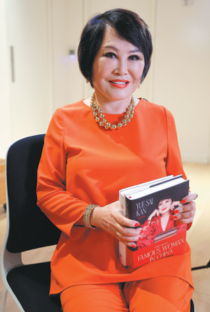Bridging East, West through culture, beauty

Yue-Sai Kan celebrates the launch of her new book at China Institute in New York City on Aug 13. JOHN LAMPARSKI/AFP
In the world of beauty, Yue-Sai Kan has dedicated decades of her life to bridging understanding between China and the world through the blending of Eastern and Western cultures.
Called "the most famous woman in China" by People magazine, Kan launched her new book, The Most Famous Woman in China and How She Did It, after this notable moniker. More than 200 people attended the book signing and panel discussion co-hosted by the China Institute in New York City on Aug 13.
"Everything I have done in my life has never been done by others, but I have always been focused on cultural exchanges between the East and the West, and I am committed to bridging understanding between China and the world," Kan said.
She said the book, her first autobiography in English, is more than just a chronicle of her life. It also offers a lens into the evolving relationship between the East and West, as seen through her eyes.
An Emmy-winning television host, producer, successful entrepreneur, fashion icon, bestselling author and philanthropist, Kan describes herself as a "pioneer "having been the first to break new ground on TV and in the cosmetics industry, influenced by her childhood experiences and pursuit of beauty.
Born in Guilin in the Guangxi Zhuang autonomous region and raised in Hong Kong, Kan received little pampering from her parents.
Caught speeding up the clock to shorten her piano practice as a little girl, Kan faced punishment from her mother with a feather duster. But she cleverly avoided it by affectionately rubbing her cheek against her mother's wrist.
Despite the strict upbringing, her mother supported her early interest in beauty, especially when she found Kan playing with jewelry or experimenting with lipstick in front of a mirror.
Her father, a painter who would start over if he found even a small detail unsatisfactory in his work, exposed her early to art. This cultivated her appreciation for beauty and instilled a strict attitude toward it.
Kan said her parents' support had contributed a lot to her growth.
At 16, Kan went to the United States to attend the Brigham Young University-Hawaii. Her experience studying in the US, coupled with her adventurous spirit, deepened her understanding of Westerners and people from diverse ethnicities and backgrounds. This experience then helped shape her commitment to represent Chinese culture through her own identity.
After a brief return to Hong Kong, Kan moved back to the US.In January 1972, she arrived at John F. Kennedy International Airport in New York with just $150 in cash.
She began her television career in New York, using her persistence and resilience to establish roots in the city.
In 1978, Kan produced and hosted the TV show Looking East, which introduced Chinese topics to mainstream US media and brought China to the US audience for the first time.
In her autobiography, Kan described how she launched the show amid skepticism from friends, quickly transitioning to a successful start.
Lack of information
At the book-signing event, Kan said the lack of information about China was why she felt compelled to create Looking East. She wanted the show to help people in the US better understand China, bridging a significant cultural gap.
In 1984, Kan was invited by PBS to host a live broadcast in China for the 35th anniversary of the founding of the People's Republic of China.
This event marked the first television collaboration between China and the US. In her book, she wrote that seeing Tian'anmen Square during the hour-long live broadcast filled her with pride.
Not only did Kan captivate the US audience, but she was also invited by the Chinese government to produce the show One World, which reached an audience of 400 million people.
This program helped Chinese viewers gain a global perspective through her eyes. The 1988 TV program introduced China's reform and opening-up process to the US audience, playing a key role in familiarizing the US with the New China.
Kan also consistently held herself to high standards. As a host, she made a lasting impression on viewers in both China and the US with her iconic "Yue-Sai Cut", vibrant clothing and signature red lips. Those elements resonated deeply with viewers in both countries.
Later, Kan founded Yue Sai Cosmetics, where she was personally involved in every step from sourcing to research and development, testing and mass production.
She integrated traditional Chinese herbal formulas into her cosmetics, creating a color palette specifically suited for sensitive skin and the complexions of Chinese women.
In her book, Kan detailed the journey of creating her cosmetics brand. Additionally, she introduced "Yue-Sai wawa" — dolls that feature black hair and yellow skin dressed in traditional Chinese attire, making a significant cultural impact.
To this day, Kan remains dedicated to fostering exchanges and cultural understanding between China and the US. Kan has built a diverse network of friends ranging from high-profile politicians and business leaders to ordinary citizens across both China and the US.
"Art, culture, education, business and culinary, always connect people," she said.














